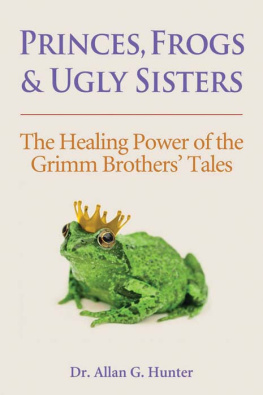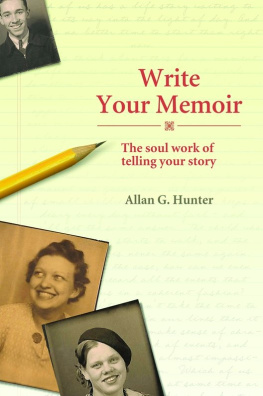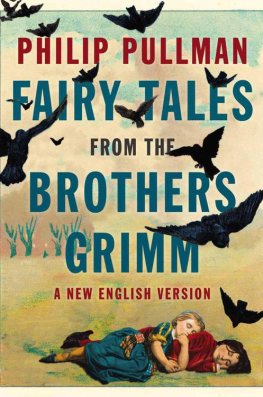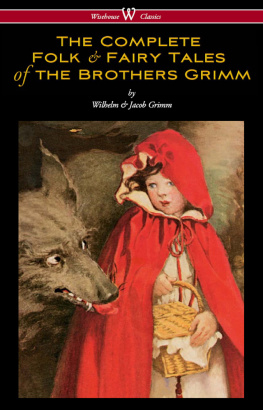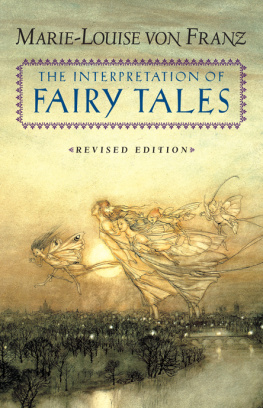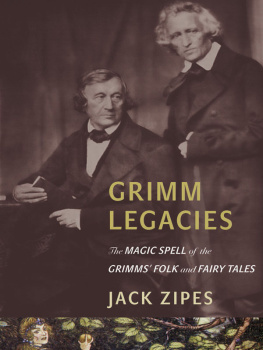
P RINCES , F ROGS
& U GLY S ISTERS

The Healing Power of the
Grimm Brothers Tales
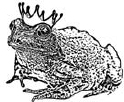
Other books by Allan G. Hunter
Stories We Need to Know
The Six Archetypes of Love
Write Your Memoir
The Sanity Manual
From Coastal Command to Captivity
P RINCES , F ROGS
& U GLY S ISTERS

The Healing Power of the
Grimm Brothers Tales

Dr. Allan G. Hunter

Allan G. Hunter 2010
The right of Allan G. Hunter to be identified as the author of this work has been asserted by him in accordance with the Copyright, Designs and Patents Act 1998.
Published in 2010 by Findhorn Press, Scotland
ISBN 978-1-84409-184-3
All rights reserved.
The contents of this book may not be reproduced in any form, except for short extracts for quotation or review, without the written permission of the publisher.
A CIP record for this title is available from the British Library.
Edited by Nicky Leach
Cover & interior design by Damian Keenan
Printed and bound in the USA
1 2 3 4 5 6 7 8 9 17 16 15 14 13 12 11 10
Published by
Findhorn Press
117-121 High Street,
Forres IV36 1AB,
Scotland, UK
t +44 (0)1309 690582
f+44 (0)131 777 2711
e
www.findhornpress.com

CONTENTS
Introduction
Why We Need Fairy Tales
Appendix
The Historical Context

Acknowledgments
I owe many thanks to many peoplenot all of whom may have been aware at the time that their comments and guidance were so helpful to me. That is part of the joy of any project that finds itself in some sort of flow or synchronicity. The ideas arrive and were not quite sure where they came from. Perhaps they come from the universe itself, or from the collective unconscious. Whatever we wish to call it, gratitude is certainly the most appropriate response.
The first person I wish to thank is Lilou Mac, who set me thinking in this direction in the first place. Laura Warrell helped to move the idea forward, and from there things gathered steam. Suzanne Strempek Shea by her generosity, insight, and enthusiasm, proved to be a friend of whom I found myself constantly saying, How did I get so lucky as to know someone like this? Its a question I still ask. Professor Tom Shippeys expertise kept the enthusiasm alive, while Baptist De Pape and Han Koorneef kept me alert to the possibilities and were extemely generous with their time as we worked together.
At Curry College I was helped considerably by receiving release time to work on this project: I owe my thanks to Dr. Ronald Warners and to Dean David Potash for making this possible, and to the colleges president, Ken Quigley, for his support.
The trustees of the Seth Sprague Educational and Charitable Foundation, Mrs. Arline Greenleaf, and Mrs. Rebecca Greenleaf-Clapp, were inspirations to me, as well as providing the support that allowed me to road test so many of the ideas that appear in these pages in my classes with the Honors Program at Curry College.
Thierry Bogliolo, of course, deserves a special thank youfor having faith in my projects and being the most supportive publisher any author could hope for. Gail Torrsimply the finest publicist in the businessreceives warm thanks and heartfelt hugs. In addition, Nicky Leach, my editor, did stellar work on the text, while Damian Keenan worked splendidly to create a cover.
People who provided inspiration include Marlena Erdos, Kelly Ferry, Briana Sitler, Simon Mason, Andrew Peerless (of Oxford University Press), David Whitley (of Homerton College, Cambridge University), and of course my wife, Cat Bennettour conversations each evening about the Grimm brothers tales were a delight and a source of insight for which I shall be forever grateful. Anna Portnoy and Nick Portnoy loaned me more support than they perhaps recognize and they deserve my particular gratitude. Sally Young of Harvard University, a genius at bringing ideas forward, deserves a special mention, and special gratitude, too.

INTRODUCTION
Why We Need Fairy Tales
Truth, naked and cold, had been turned away from every door in the village. Her nakedness frightened the people. When Parable found her she was huddled in a corner, shivering and hungry. Taking pity on her, Parable gathered her up and took her home. There she dressed Truth in Story, warmed her, and sent her out again. Clothed in Story, Truth knocked at the villagers doors and was readily welcomed into peoples houses. They invited her to eat at their table and to warm herself by their fire.
JEWISH TEACHING STORY
S ome years ago I was invited to give a presentation to an organization called The Man Panel. Id been asked to speak about the obstacles men and women tend to run into when they go out looking for a significant other. Just before we began, one of the organizersa strikingly beautiful young woman in her thirtiesturned to me and said: Just so you know: these people here tonight, theyre all tired of being Cinderellas. And so am I. I want that fairy godmother, and I want that prince to turn up, and soon.
I looked at her and smiled. It sounds like you only know the Disney version of the story, I commented. If you go to the original versionthe Grimm brothers versiontheres no fairy godmother.
The woman looked shocked, her eyes wide. No fairy godmother? she exclaimed.
Thats right. And theres no pumpkin that turns into a coach, either, I continued. Whats more, Cinderella doesnt sit around waiting for the prince. She takes her courage and she goes out to find him.
She does?
She most definitely does, and not just once but three times. The real tale will tell you what youll need to do to be successful in love, but you have to know what it says and forget the saccharine Disney version. That version will tell you nothing.
I could give many examples of this sort of conversation, but theyd all point the same way. Theyve shown me, again and again, how weve been misled by the sanitized versions of the old fairy tales. Weve assimilated the commercialized versions, while the real talesfull of wisdomremain unread. Its time to redress the balance. If we guide our thinking by referring to the wrong stories, then we do ourselves no favors.
Next page
